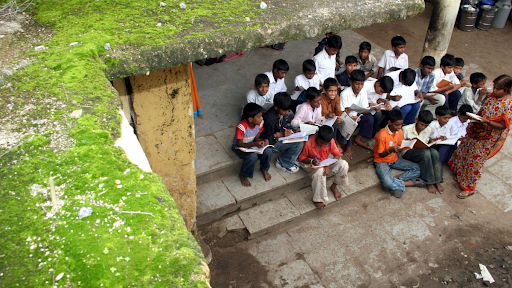Description

Copyright infringement not intended
Picture Courtesy: https://www.thehindu.com/news/cities/Delhi/nirf-rankings-du-jumps-five-places-to-enter-top-10-university-club/article68517893.ece
Context: The National Institutional Ranking Framework (NIRF) 2024 ranking was released by the Union Education Minister Dharmendra Pradhan.
Details
- National Institutional Ranking Framework (NIRF) 2024 were released for 16 categories this year, three more than last year, with open universities, skill universities, and State public universities being the three new categories.
- The Indian Institute of Technology (IIT) Madras has been ranked as the best education institution in the country for the sixth time since 2019, and IIT Madras also retained its first position in engineering for the ninth year since 2016.
- A total of 6,517 institutions participated in the ranking under overall, category-specific, or domain-specific rankings. The Union Education Ministry said that there was a "noticeable increase" in institutional participation in the rankings exercise.

NIRF Ranking 2024
|
Category
|
Rank 1
|
Rank 2
|
Rank 3
|
|
Engineering Institutes
|
IIT Madras
|
IIT Delhi
|
IIT Bombay
|
|
Universities
|
IISc, Bengaluru
|
JNU, New Delhi
|
JMI, New Delhi
|
|
Overall Institutes
|
IIT Madras
|
IISc, Bengaluru
|
IIT Bombay
|
|
Management Institutes
|
IIM Ahmedabad
|
IIM Bangalore
|
IIM Kozhikode
|
|
Medical Colleges
|
AIIMS, New Delhi
|
PGIMER, Chandigarh
|
Christian Medical College, Vellore
|
|
Colleges
|
Hindu College, Delhi
|
Miranda House, Delhi
|
St. Stephen's College, Delhi
|
|
State Universities
|
Anna University, Chennai
|
Jadavpur University, Kolkata
|
Savitribai Phule Pune University, Pune
|
|
Law Institutes
|
National Law School of India University, Bengaluru
|
National Law University, Delhi
|
NALSAR University of Law, Hyderabad
|
|
Architecture and Planning Institutes
|
IIT Roorkee
|
IIT Kharagpur
|
NIT Calicut
|
|
Open Universities
|
IGNOU
|
Netaji Subhash Open University, Kolkata
|
Dr. Babasaheb Ambedkar Open University, Ahmedabad
|
|
Innovation
|
IIT Bombay
|
IIT Madras
|
IIT Hyderabad
|
|
Agriculture and Allied Sectors
|
Indian Agricultural Research Institute, New Delhi
|
ICAR- National Dairy Research Institute, Karnal
|
Punjab Agricultural University, Ludhiana
|
|
Research Institutes
|
IISc, Bengaluru
|
IIT Madras
|
IIT Delhi
|
|
Dental Colleges
|
Saveetha Institute of Medical and Technical Science, Chennai
|
Manipal College of Dental Sciences, Manipal
|
Maulana Azad Institute of Dental Science, New Delhi
|
National Institutional Ranking Framework (NIRF)
- It is a ranking system adopted by the Ministry of Education, to assess and rank higher education institutions across the country.
- This framework was introduced by the former Ministry of Human Resource Development (MHRD), now known as the Ministry of Education, and was officially launched in 2015.
- The NIRF provides rankings in various categories such as universities, engineering, management, and more, using specific parameters to ensure a comprehensive evaluation.
|
Key Milestones
●2016: The first rankings were released, covering four categories: Universities, Engineering, Management, and Pharmacy.
●2017: Two additional categories, Overall and College, were added, with around 3,000 institutions participating.
●2018: The number of participating institutions increased, and the rankings were released on April 3.
●2020: The rankings expanded to include dental institutes, with around 3,800 institutions participating, reflecting a 20% increase from the previous year.
|
Ranking Parameters are grouped into five clusters:
- Teaching, Learning, and Resources (TLR)
- Research, Professional Practice, and Collaborative Performance (RPC)
- Graduation Outcomes (GO)
- Outreach and Inclusivity (OI)
- Perception (PR)
Weights Assigned to Parameters
- The weightage assigned to each parameter depends on the category of the institution. For engineering, management, pharmacy, and architecture institutions, the weightage distribution is as follows:
|
Parameter Group
|
Category A Institutions
|
Category B Institutions
|
|
Teaching, Learning, and Resources (TLR)
|
30%
|
30%
|
|
Research, Professional Practice, and Collaborative Performance (RPC)
|
30%
|
20%
|
|
Graduation Outcomes (GO)
|
15%
|
25%
|
|
Outreach and Inclusivity (OI)
|
15%
|
15%
|
|
Perception (PR)
|
10%
|
10%
|
Explanation of Parameters
- Teaching, Learning, and Resources (TLR): This measures the quality of teaching, learning resources, and facilities available to students.
- Research, Professional Practice, and Collaborative Performance (RPC): This parameter focuses on the research output, professional practices, and collaborations with other institutions or industries.
- Graduation Outcomes (GO): This evaluates the success rate of students graduating from the institution, including their placements and higher studies.
- Outreach and Inclusivity (OI): This measures the diversity and inclusiveness of the institution, considering factors like the representation of women, economically disadvantaged students, and differently-abled individuals.
- Perception (PR): This reflects the reputation of the institution as perceived by the public, including academics, employers, and the general community.
Significance of NIRF Rankings
It promotes quality and accountability in higher education
- Comparative Performance: NIRF rankings provide organizations with benchmarks to measure their performance in areas such as teaching, research and infrastructure Providing standardized benchmarking enables organizations to identify strengths and areas of need they improve.
- Promotes Accountability: Organizations are motivated to improve their quality and transparency to be ranked higher. The ranking process encourages them to adopt best practices and improve on all standards.
Reports to students and parents
- Scholarship Selection: For prospective students and their families, the NIRF score is a valuable tool for making informed higher education decisions. The rankings provide insights into the quality of education, services and teachers in various institutions.
- Emphasis on excellence: Highly ranked institutions tend to increase visibility and recognition, which can attract students seeking quality education and career prospects.
Facilitates institutional development
- Resource allocation: Organizations often use their NIRF numbers to recommend better funds and resources. Higher degrees can justify investments in infrastructure, research and faculty development.
- Implementation Planning: Tables help organizations set actionable goals and measure progress over time. They provide a framework for planning and decision-making.
It encourages competition and innovation
- Healthy Competition: NIRF positions foster a spirit of healthy competition between organizations. This competition motivates institutions to rank better and improves their innovative educational practices.
- Innovation in Education: Institutions striving for higher degrees are often at the forefront of adopting new teaching methods, research programs and technological developments.
It supports government policy and planning
- Policy formulation: The data obtained from the quantitative NIRF helps the government formulate policies and programs to improve higher education. It provides insights into the performance of the organization and areas in need of intervention.
- Evaluation and Evaluation: NIRF is a monitoring tool to assess the impact of education programs and initiatives over a long period.
Conclusion
- The NIRF has become an essential tool for assessing and ranking higher education institutions in India, providing students, parents, and policymakers with valuable insights. The framework's structured approach ensures that rankings are based on objective criteria, contributing to the overall improvement of educational standards in the country.
Must Read Articles:
Gender Gap In Education In India
State Of Elementary Education In Rural India Report
National Education Policy (NEP) 2020
Source:
Economics Times
Wikipedia
|
PRACTICE QUESTION
Q. Assess the challenges and opportunities of digital education and e-learning in India. How can technology integration be adapted to address differences in educational environment and quality across sectors?
|












